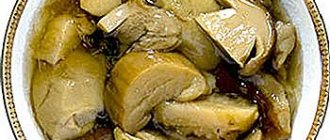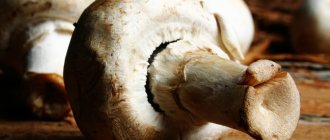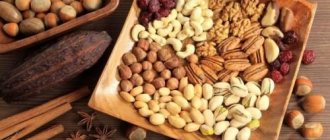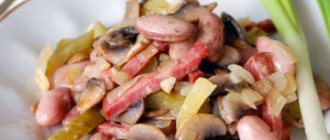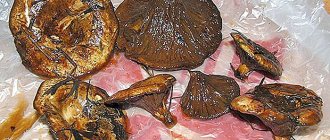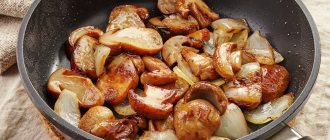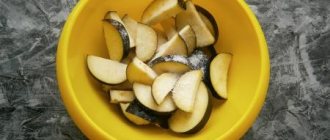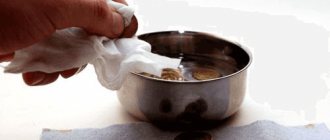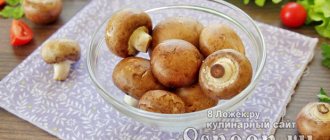Mushrooms
0
1236
Article rating
Kira Stoletova
The first priority after harvesting is processing the mushrooms. There is no need to delay the process, because the product quickly deteriorates. If it is not possible to process the crop immediately after arriving from the forest, you are allowed to postpone work for only a few hours. To properly prepare mushrooms for consumption, you need to learn certain rules.
Mushroom processing
How to properly clean boletus mushrooms
Before you start cleaning, you need to decide what kind of treatment they will be subjected to later. For example, if after cleaning they will be fried, boiled or frozen, then in this case a completely different approach is needed than before drying them.
Before frying or boiling
Fried boletus mushrooms are a delicious and unusual dish. To prepare it, the mushrooms must be cleaned and prepared. Basic cleaning principles:
- Using a knife, remove all debris (grass, leaves, dirt) from the surface of the fruit. Trim the bottom of the damaged leg.
- If the harvest was carried out after rain, then the mushrooms must be immersed in water for a quarter of an hour. The liquid should be salty. Soaking will make it possible to easily remove the remains of debris and sand, which are removed with great difficulty. If the fruits were collected in dry weather, they do not need to be soaked, but washed immediately.
- After washing, the mushrooms should be discarded in a colander. While they are draining, you need to trim off the damaged or darkened areas with a knife. Immediately before frying, it is worth cutting in half, and large specimens - into 4 parts.
After cutting, pour boiling water over the porcini mushrooms and place them in a colander again. When they dry a little, they can be fried.
As for preparation for cooking, it is no different from the previously described processes.
The only difference: the fruits do not have to be divided into parts. Although some housewives like to fry such mushrooms after preliminary boiling. In this case, cutting them would be advisable.
Before freezing
But cleaning boletus mushrooms intended for freezing is somewhat different from the process described above. First of all, mushrooms should not be washed. They absorb moisture like a sponge, and its excess will lead to the fact that after defrosting the product will wrinkle and become unfit for consumption.
All other cleaning methods are the same. In this case, washing is replaced by wiping the mushroom surface with a clean damp (not wet!) towel.
Such rubbing must be carried out in several stages. The first is performed in order to remove dirt and debris from the fruit. The second stage is the final one. That is, the mushrooms are wiped, then they need to be allowed to dry a little, after which they can be packaged in containers or bags and sent to the freezer.
For canning
Preparing boletus mushrooms for canning often does not involve boiling them. In this case, an important role is played by soaking forest gifts. After the initial soaking, all debris is removed from the surface of the fruit using a soft brush or the back of a kitchen sponge.
Next, the fruiting bodies need to be wiped with a damp cloth and soaked in salted water. The soaking period is 20 minutes. But during this time the water needs to be changed at least 2 times. Along with salt, you can add vinegar or citric acid to the liquid.
After soaking, final cleaning of the boletus mushrooms is carried out. Damaged areas should be removed, mushrooms should be cut in half and inspected. Good fruits can be preserved, but bad ones can be thrown away.
For drying
Boletus mushrooms intended for drying should never be washed. It will be enough to clean their surface with a brush, after which you can wipe with a damp cloth.
Helpful advice! If the mushroom has a stem that is too thick, then it needs to be separated from the cap, cut into slices about 0.3 cm thick and dried.
Porcini mushrooms (Boletus mushrooms)
The height of the boletus can reach 25 centimeters. On average, the height of a standard mushroom is 12 centimeters. The cap of a porcini mushroom has an average diameter of 30 centimeters, but there are cases where boletus mushrooms were found with a cap whose diameter reached 50 centimeters. The dryness or moisture of the cap is determined by the growing environment. For example, in dry areas of the forest, porcini mushrooms with a dry cap grow. Accordingly, in the shady side of the forest, where there is high humidity, the mushroom caps are slightly damp to the touch.
Useful properties of porcini mushroom.
However, housewives love porcini mushrooms for their ease of cleaning, beneficial properties and for their fleshy cap. Despite the fleshy cap, the porcini mushroom is considered a low-calorie product, as a result of which it is classified as a dietary product.
Porcini mushrooms contain a group of vitamins A, D, C and B1. However, if the mushrooms were collected along busy highways and in industrial areas, then it is better not to eat such mushrooms. Porcini mushroom is a very powerful sorbent that can absorb all toxic substances.
How to clean porcini mushrooms in the forest?
You need to peel the porcini mushroom, like all collected mushrooms, in two steps.
- The first stage is preliminary cleaning directly at the collection site. This saves enough time for the next cleaning.
- After the mushroom is picked and before putting it in the basket, pine twigs, leaves and adhered dirt should be shaken off the porcini mushroom.
- Any mushroom picker always has a knife with him. If worms have already encroached on the mushroom, then it is better to cut off even small parts without sparing them.
How to clean porcini mushrooms at home?
Basically, the white mushroom grows on dry, not too dirty surfaces. For this reason, the question often arises: how to clean porcini mushrooms and is it worth cleaning them at all? Worth cleaning. Dangerous bacteria can accumulate in the stems of the mushroom, causing a disease such as botulism. In addition, this bacterium does not die even after heat treatment.
First, decide why you need mushrooms.
They are often used for pickling, salting, frying or drying. Mushrooms intended for drying should not be washed. Professionals advise simply going over the entire mushroom with a special brush, which you can buy at any hardware store. This brush looks like a regular toothbrush. If you don't have a special brush, you can use a medium-hard toothbrush. The knife is used only to cut off all darkened areas and wormholes. Despite the advice, it is still worth rinsing the porcini mushrooms. To do this, you need regular cool running water. The washing procedure should be carried out very quickly, since with prolonged contact with water, the porcini mushroom loses most of its beneficial properties, and may simply lose its taste.
Popular Schlumberger articles home care: basic principles of plant maintenance
For cooking, the cap is separated from the stem (when preparing certain dishes, different parts of the mushroom are used). Depending on the size, the porcini mushroom cap can be cut into two or more parts. The mushroom stem is usually cut into small circles.
Small details:
- Any mushrooms should be cleaned immediately after returning home.
- The maximum time from collection to preparation is 5 hours.
- If you don’t have time to immediately peel the mushrooms, you can soak them for a while in cold water, to which a pinch of salt and a little citric acid have been added.
- If you come across hard specimens and have doubts about their quality, then you can use a trick. Mushrooms intended for freezing are boiled for 10 minutes in salted water.
- If the mushrooms are intended for cooking, they are scalded with boiling water.
Culinary processing and methods of harvesting mushrooms
Mushrooms - wonderful and tasty gifts of the forest - will be even tastier if they are properly prepared. First of all, this is necessary so that various microorganisms, larvae and other invisible parasites cannot live and develop in mushrooms.
Of course, some mushrooms can be eaten raw, but in the vast majority of cases heat treatment is necessary. There are several ways to prepare mushrooms, each of which can be part of a process or a recipe in its own right.
What should you do with mushrooms first? First, the mushrooms must be sorted by type and size, cleaned of debris, adhering leaves, dirt and pine needles. Then you should check the mushrooms for damage. Bruises, brown spots and parts eaten away by worms and slugs should be removed.
In some cases, it is necessary to remove the damaged cap (from russula, boletus and others), since it most often contains the main amount of harmful alkaloids. For old and overripe mushrooms, cut off the bottom of the cap, the so-called spore-bearing part.
Rough old legs are also cut off. It is better to process mushrooms on the day of collection. This is important for preserving all the beneficial qualities of forest gifts. If for some reason it is not possible to process them on the same day, they can be left until the morning. In this case, the mushrooms should be cleaned of dirt and leaves, but not washed! It's a good idea to place the mushrooms in the refrigerator or a cool, dark place. Mushrooms intended for cooking can be filled with cold water.
Washing and soaking mushrooms
. This method often precedes any cooking of mushrooms. Forest gifts must always be thoroughly cleaned of debris, dust and dirt in order to continue preparing healthy dishes from them. The exception is mushrooms intended for drying - they cannot be washed or wet at all, but only carefully remove all debris and wipe with a damp cloth.
Mushrooms should not be washed for a very long time, otherwise they can absorb a lot of water, which later complicates the cooking process. Usually rinse under running water for several minutes and allow the water to drain.
Porcini mushrooms are scalded with boiling water 2-3 times to give elasticity and reduce fragility when cutting. Dried mushrooms are soaked for 2-4 hours, after which they are boiled in the same water for 40-60 minutes. Sometimes pickled mushrooms are soaked if they are going to be added to soup or fried.
Cooking mushrooms
– the most common method of cooking mushrooms. It allows you to reduce the content of dangerous poisonous alkaloids in mushrooms, such as gilvelic acid, contained in some mushrooms, especially morels and strings. When cooking, the acid goes into water, so these mushrooms are boiled twice, be sure to pour out the water after cooking, and the mushrooms are washed in hot water. It is necessary to boil yellow and black milk mushrooms, brittle russulas, and pink frills. Cooking reduces radioactive contamination if you are unsure of the mushrooms collected or the collection area. Thus, one-time cooking for 10 minutes reduces radiocesium radiation by 81%, and two-time cooking by 97%.
Soaking also has a good effect on reducing radioactivity. It is important to remember that cooking also reduces the content of useful substances, such as vitamins, in mushrooms. In order to minimize the loss of vitamins, little water is needed for cooking. The more water is used in relation to mushrooms, the less vitamins will remain in the finished dish.
Roasting mushrooms
. You can fry almost any mushroom. Some types require mandatory pre-cooking, at least for 10-20 minutes. Perhaps only white mushrooms, champignons and chanterelles can be fried without any preparation.
Large mushrooms are cut into equal, not too large (but not very small) pieces and thrown into a frying pan with thick walls, preferably cast iron. A lot of moisture comes out of the mushrooms; they literally swim in the juice, which evaporates and bubbles abundantly. This is fine.
When the juice becomes critically low, you can add oil, onions and spices and, after frying until done over a moderate flame, remove the mushrooms from the heat and let them simmer in a hot frying pan. It is important to prevent the mushrooms from sticking to the bottom of the pan. You can use non-stick cookware for this, but mushrooms taste better in a heavy cast-iron frying pan.
Blanching mushrooms
. With this processing method, mushrooms are scalded with boiling water or immersed in boiling water for some time (usually several minutes). Sometimes boiling water is replaced with steam. In this case, the mushrooms are kept over steam in a sieve. Russulas and saffron milk caps are usually blanched. The general procedure is as follows. The amount of water should be 4 times the volume of mushrooms.
Dip small whole or large mushrooms cut into pieces in boiling water for 2-3 minutes, then place in cold water for 5-10 minutes, or even better - under a running stream of ice water for quick cooling. The same steps apply when using steam. Blanching destroys most unwanted microorganisms and is especially suitable for mushrooms that are planned to be frozen. Some types of mushrooms can be preserved after blanching, for example porcini mushrooms.
Stew mushrooms
Can be done either alone or with other vegetables, such as potatoes. This is one of the most delicious ways to cook mushrooms. Mushrooms are stewed with potatoes, sour cream or butter, this makes them slightly steamed and fried, permeating the entire dish with their aroma. You can bake mushrooms in the oven, just like vegetable dishes. The requirements and conditions are approximately the same.
Procuring mushrooms for future use by practical housewives allows you to enjoy mushroom dishes all year round. There are several basic ways to preserve mushrooms: pickling, pickling and freezing, each of which adds its own flavor profile.
One very important detail - you cannot add onions to mushrooms if they are intended for preservation. Such mushrooms will definitely spoil. Onions should be added during the actual preparation of the mushroom dish.
Pickling mushrooms
. Lamellar mushrooms are especially well suited for this method - russula, volushki, saffron milk caps, milk mushrooms, honey mushrooms, chanterelles and others. There are two methods of salting - cold and hot. Cold means that selected and sorted mushrooms are soaked in cold water for 2-3 days.
The water is changed periodically, as mushroom milky juice is released into it. All cold salting operations are best carried out in a cool room - in the basement or cellar. This is necessary to prevent the mushrooms from fermenting. The soaked mushrooms are placed in an enamel bowl or barrel to the brim, sprinkled with salt (3-4% salt, or 300-400 g of salt per 10 kg of mushrooms), seasonings and spices are added.
You can dwell in detail on this important element of salting. It is the spicy herbs that form the necessary fragrant aroma, which, when combined with the mushroom one, creates that alluring bouquet that so awakens the appetite. Currant leaves, bay leaves, garlic, dill, pepper and sometimes basil are placed at the bottom of a barrel or large enamel pan, then a layer of mushrooms, then again a layer of spices and so on, not forgetting to sprinkle with salt.
(Saffron milk caps do not require spices; they should be added very carefully.) A heavy wooden circle with holes is placed on top of all layers or, as a last resort, a lid of smaller diameter than the container, sometimes a weight is added on top. This is called salting “under oppression.” Gradually, as the mushrooms settle in the pickling container, you can add a few more layers and place the mushrooms in a dark, cool place.
The saffron milk caps will be ready in 10-12 days, and the milk mushrooms in 30-40 days. The hot salting method requires preliminary blanching. The scalded mushrooms are then placed on a sieve or sieve, the water is allowed to drain and placed in a bowl with spices and salt. Then proceed according to the same scheme as with the cold method.
Marinating mushrooms
. Usually they marinate mushrooms, which when fresh (boiled, fried and stewed) are not as tasty as their counterparts growing at the same time. For example, porcini mushrooms are usually eaten fresh, although they can also be salted and pickled, but this is considered impractical in relation to delicious porcini mushrooms.
Although, if the harvest of porcini mushrooms is especially large and all the mushrooms are simply physically impossible to eat fresh, they are, of course, stored for future use. The most commonly pickled vegetables are boletus, honey mushrooms, saffron milk caps, chanterelles, aspen boletuses and boletus mushrooms.
Different types of mushrooms should be marinated separately. You cannot mix different mushrooms in one container, otherwise they will either darken and become uniformly brown and ugly, or will cook unevenly. Moreover, to preserve the taste, it is good to cook the stems and caps of even one type of mushroom separately. You need to remove the skin from the cap of the buttermilk. Here is one of the many pickling options. Pour the mushrooms into a pan (non-oxidizing, preferably enameled), after cleaning, rinsing, dividing into types and stems. Pour water, add salt, spices and citric acid.
Next, cook the mushrooms until they settle to the bottom and the broth becomes transparent. Skim the foam periodically and be vigilant - mushrooms require attention. At the very end of cooking, add vinegar mixed with mushroom broth. Then pour the mushrooms along with the broth into prepared (sterilized) jars, close the lids, sterilize the jars in boiling water: liter jars for half an hour, half-liter jars for five minutes less. After sterilization, quickly roll up the jars with lids and leave to cool.
Drying mushrooms
. Very good and simple method. Suitable for almost everyone, as it does not require complex operations and special equipment, or this equipment can be made at home.
If not all, then many mushrooms can be dried. Usually dried are white mushrooms, honey mushrooms, boletus, boletus, boletus, champignons and chanterelles. You can dry mushrooms in the sun, in ovens, ovens and other heating devices. Dry outdoors in dry and sunny weather. In high humidity or without sun, mushrooms can become moldy.
Whole, undamaged specimens not eaten by worms and caterpillars are selected for drying. The mushrooms are cleaned of debris (leaves, lumps of dirt, pine needles, etc.) and wiped with a damp cloth (but not washed - the mushrooms will absorb water and dry very slowly, which can ruin them). It is best to dry on wooden racks or meshes.
There are many methods of drying in a Russian oven, but since ovens are now a museum rarity, we will not list them. Each house has a stove with oven. The general principles of oven drying can also be applied to oven drying. It is important to remember that in the oven the heat comes from all sides and dries evenly, but in the oven the heat comes from below and therefore the mushrooms need to be turned over to dry evenly.
The ideal temperature for drying is within 60-70 degrees, but no more, otherwise the mushrooms can be overdried, they will become brittle and lose their beneficial properties and taste. Mushrooms release a lot of moisture, so it is advisable to keep the oven door slightly open. The degree of readiness of the mushrooms is determined by bending test. Mushrooms should be light, dry, bend slightly, and break if pressed. If the mushrooms break even with little effort, it means they are overdried.
Freezing mushrooms
is now one of the most accessible methods of harvesting mushrooms for future use. For freezing, you should select strong, small-sized mushrooms collected in a dry forest. White boletus, boletus, boletus and champignon mushrooms are well suited for this.
The freezer temperature should be -18 degrees or lower (usually three degrees in household refrigerators). The best result is achieved by pre-blanching. Prepared mushrooms are placed in plastic bags and placed in the freezer.
It is better to freeze those types of mushrooms that do not require long cooking. You can freeze boiled or fried mushrooms, divided into portions per cooking – for convenience. You should prepare dishes from frozen mushrooms only after they have been completely defrosted. Very small mushrooms can be placed in small baby food jars - such a jar is enough for one quickly prepared serving. Frozen mushrooms can be stored for quite a long time - up to two years, but they are usually stored until next summer.
Mushroom powder
. Mushroom powder is good because it is easy to use in cooking, adding it to all kinds of dishes: gravies, sauces, soups, or to add a mushroom flavor when stewing vegetables. In addition, crushed mushrooms are better absorbed by the body. It is best to prepare mushroom powder from porcini, saffron milk caps, chanterelles, boletus and aspen mushrooms, or from a mixture of different mushrooms.
To prepare the powder, the mushrooms are first thoroughly dried and then ground in a coffee grinder, pepper mill, or mortar in a porcelain cup. If the powder turns out to be heterogeneous, large particles can be sifted out through a fine flour sieve and ground additionally. Before cooking with mushroom powder, it must be soaked for 20-30 minutes to swell and then added to the dish 10-15 minutes before cooking.
26718
Other news in the section:
- During the honey mushroom season, X-Fit presents culinary hits
- How many calories are in mushrooms
- How to fry champignons
- Mushrooms help with diets and vitamin D deficiency
- Boost Your Overall Health with Reishi Mushrooms
Cleaning in the forest
The preparatory stage for cleaning porcini mushrooms is to carefully examine them after cutting. The product must be inspected from all sides for visible structural damage, insect marks or rot.
Next, start cleaning the legs. The lowest part must be completely removed due to the large accumulation of dirt. The cut site is inspected for the presence of worm passages. If there are large quantities of them, it is better to throw away the mushroom. A few passages are not dangerous and should be carefully cut with a thin knife. This must be done immediately after collection: the worm can spread to other mushrooms in the basket.
The next step is to inspect the bottom of the cap. It often contains small insects, worms and the remains of their vital activity.
The hat must be carefully cleaned of pine needles, moss and grass.
Rules for collecting and purchasing mushrooms
Before you cook wild mushrooms, you must be absolutely sure that they are edible. If you are not entirely sure about this, it is better to discard the mushrooms. Among poisonous mushrooms there are many edible counterparts, and they can easily be confused. Even one such mushroom is enough to poison your entire family. There were cases when entire families died from eating toadstool.
In addition, you need to beware of buying salted and canned mushrooms from random sellers, since in their processed form it is impossible to distinguish edible mushrooms from inedible ones, and if only one small poisonous mushroom gets into the jar, this will be enough to cause fatal poisoning. You can distinguish edible mushrooms from poisonous ones only in their raw form. Therefore, remember the important rule for buying mushrooms - you can only buy them raw from strangers, and you need to buy mushroom preparations exclusively in the store.
In addition, it is necessary to remember that you should not eat wormy or old, overgrown mushrooms, since in both cases a large amount of toxins accumulate in the mushrooms and they become poisonous.
According to the rules for collecting mushrooms, you cannot go on a “quiet hunt” in very hot weather, since toxic substances also accumulate in the fruiting bodies.
Raw forest products (with rare exceptions) cannot be stored for a long time. In accordance with the rules for preparing mushrooms, they must be used no later than two days after collection (eat or process).
Preparing mushrooms
After arriving home, you should immediately distribute them by type to make it easier to figure out how to process mushrooms and what to cook from them. Then you need to take a sharp knife and cut out all the dark places, and also check the product for the presence of insects or worms. The caps must be carefully wiped with a brush or brush, and then the tip of the stem must be cut off.
When all the mushrooms are cleaned, they should be washed thoroughly
But this must be done with extreme caution, since a long stay in water will not have the best effect on the quality, and their taste will change slightly. Mushrooms must be placed in a colander and rinsed a little with cold water, and then allowed to drain.
If you know how to properly process mushrooms, then the juice that remains should not be thrown away. It can be used to prepare other dishes.
If there are a small number of wormholes on the mushrooms, the product should be soaked in cold water, after adding salt. Then the worms will come out and remain in the container with water. In the case where the mushroom is very difficult to wash, since it is excessively contaminated, it can be placed in water and left for some time.
It is more convenient to wash in a basin or in a large saucepan
It is important that the mushrooms are covered with water. To prevent them from floating up, you can put plywood or a board with a small weight on top
Once the leaves and other debris are soaked, it will be very easy to separate them.
Those mushrooms that are intended for pickling must be soaked. For milk mushrooms, you should scrape off the top black layer with a knife, and for buttermilks, remove the films from the caps. When thinking about how to process volushka mushrooms, you should remember that they are soaked raw and then pickled.
Those species that contain milky bitter juice need to be soaked for 2-3 days, changing the water at least three times a day. It is better to place the container in a cool place so that the mushrooms do not sour.
Experienced mushroom pickers claim that soaking is not as beneficial as is commonly believed. This is due to the fact that along with bitterness, nutrients and protein substances leave, the nutritional value of the product decreases, and the mushroom becomes soft and flabby. Therefore, experts do not recommend soaking for more than 2 days. If you figure out how to process mushrooms, then after cooking they will always turn out delicious.
When sorting, you need to pay special attention to whether there are any poisonous species in the basket. Some toadstools are very similar to russula
You can distinguish them by their stem: if the russula is real, its stem is straight to the very base, while in a false mushroom it expands downwards. It will also be useful for beginners to know that the skin of the toadstool cap is removed from the edge to the center. If there are doubts about the quality, you should never use them; it is better to throw them away immediately. You should not collect those mushrooms that grow near highways or landfills: they can cause severe poisoning.
The need for high temperatures
One of the mistakes when cooking mushrooms is low cooking temperatures. This problem is especially relevant if you choose the wrong dishes.
Thus, it is advisable to cook mushrooms in a container with thick walls, for example, in a cast iron kitchen pan. This product heats up quickly and retains heat for a long time. If you use other cookware when adding cold mushrooms, the temperature may drop sharply, which will result in disruption of the cooking process.
Mushrooms are best fried in cast iron (Photo: Pixabay.com)
To make the mushrooms tasty and appetizing, you only need to place them in a hot frying pan and fry for 2-3 minutes, stirring occasionally. If the mushrooms brown too quickly, simply reduce the heat.
How to clean boletus?
In general, to clean these mushrooms, we recommend that you learn something about them:
1. If you have never peeled these mushrooms, then start peeling them from the cap. Work your way down gradually, but don't forget to clean under the cap because that's where debris collects.
2. If you have collected young specimens, there is no need to remove the skin. Older mushrooms require the skin to be removed because it may taste bitter. But some gourmets even like this feature of mushrooms and do not pay much attention to it. If you want to pickle mushrooms, the skin must be cleaned. Because if you don't clean them, the marinade will become like jelly and the mushrooms will look tasteless.
3. The oiler should only be cleaned when dry. Other mushrooms can be soaked in water, but these should never be soaked. These mushrooms have a spongy structure that absorbs water very well. The skin becomes slippery and you won’t even be able to hold them in your hands.
4. It is recommended to wash boletus immediately after cleaning.
5. Cleaning boletus is very long and tedious. Therefore, it is recommended to involve other family members in this activity, and then you will do it quickly and unnoticed.
Popular articles Where and when porcini mushrooms appear
6. If you want your hands to remain clean, you need to wear rubber gloves.
Preparing mushrooms
Before an activity such as cleaning, you must determine what you will do with the mushrooms in the future. If you want to dry them, there is no need to clean the cap. All you need to do is remove all the debris and sand. If the mushrooms are very dirty, you can take a knife and scrape off these areas or just cut them off. Then you need to remove all remaining dirt from the mushrooms with a soft cloth. Also know that oils do not require washing in water after cleaning.
If you then want to make a dish from these mushrooms that requires heat treatment, then the fruiting body of the mushroom needs to be cleaned more thoroughly. But how to quickly clean boletus with minimal time? It turns out that there are a lot of ways to clean mushrooms, which we invite you to get acquainted with. You can choose one of them which you like the most.
How to wash and peel porcini mushrooms for freezing
Modern kitchen appliances, in particular freezers, allow you to enjoy boletus not only during the harvest season, but also in winter. Naturally, for this, the fruiting bodies need to be properly prepared and cleaned.
Unlike cleaning before salting or heat treatment, preparing boletus mushrooms for freezing includes mandatory washing and soaking in salted water. First, we carry out traditional activities: we clean the caps and stems from large debris, cut off the lower part of the stem and place the fruiting bodies in a large bowl or pan with salted water. The mushrooms should sit in this solution for about an hour. This will make it possible to remove insects, worms or insect larvae from the pulp that may be accidentally missed during the cleaning process (Figure 5).
Next, remove the boletus mushrooms from the salt water, rinse thoroughly and place in a colander. To make the frozen product truly tasty and aromatic, it is better to remove excess moisture from the surface. After this, it is enough to put them in bags or containers. Small specimens can be frozen whole, but large ones are better cut into several pieces.
Figure 5. Preparing porcini mushrooms for freezing
If you want to make a preparation that will be almost ready to eat after defrosting, it is better to cut the boletus mushrooms into small pieces, lightly boil them in water and place them in portioned bags or containers. As a result, you will receive a ready-made preparation that will help you prepare delicious fried mushrooms at any time of the year.
Not all mushrooms can be dried
The most successful way to prepare mushrooms for the winter is drying. In this case, they will retain their beneficial properties, the aroma will become even more pronounced, and such mushrooms can be used for preparing soups and main courses. But if you have collected a whole basket, do not rush to start drying right away. Unfortunately, not all mushrooms are suitable for this storage method.
Mushrooms need to be dried for a long time at a low temperature (Photo: Pixabay.com)
This is due to the bitterness they contain, because during the drying process it will become even stronger. Porcini mushrooms, boletus mushrooms, honey mushrooms and chanterelles are best suited for this. To dry, rinse the mushrooms thoroughly, dry them with a paper towel and place in the oven. After this, transfer it to a fabric bag.
How to clean porcini mushrooms before freezing
Washing is the most important preparatory process. The quality of finished products depends on its thoroughness
Therefore, special attention should be paid to washing, taking into account at the same time that during prolonged washing there is a loss of aromatic and soluble solids. Therefore, washing time must be limited
You can wash the mushrooms well without loss for 10 minutes, changing the water several times. It is best to wash mushrooms in running and continuously changing water, especially with a high-pressure jet
Before cleaning porcini mushrooms before freezing, note that if the porcini mushrooms are excessively saturated with water, this indicates that they are overgrown or damaged. During the decay process, substances harmful to health can be formed, such as the poison neurin, as a result of which edible mushrooms can become poisonous
You cannot pull mushrooms out of the ground, because this disrupts the structure of the mycelium, after which the threads of the mushroom mycelium die off and do not bear fruit. Mushrooms must be carefully cut with a knife.
After cutting the mushroom, check if it is wormy. In addition, by cutting off the mushrooms with a knife, we reduce the possibility of them becoming contaminated with stuck soil. Collected mushrooms are immediately cleaned of soil, leaves, pine needles, grass and other debris adhering to them; remove parts affected by insect larvae. Heavily contaminated lower parts of the legs are cut off. It is better to put mushrooms in the basket with their caps down - this way they are better preserved.
They may also contain insect larvae. To remove them, you need to soak the mushrooms for 2 minutes in a one percent salt solution - 10 g of salt per 1 liter of water. Soaking will also help to partially clean the mushrooms from soil, pine needles, particles of manure and peat, which may contain parasites and microbes. And only after soaking, the mushrooms are placed in a colander and washed under running cold water for several minutes.
See how to clean porcini mushrooms before cooking in the photos showing the intricacies of this process. Cleaning porcini mushrooms before drying.
One of the simplest methods of processing mushrooms is drying. Porcini mushrooms (boletus mushrooms) are most suitable for drying. The mushrooms are carefully examined and cleaned with a knife to remove moss, leaves, pine needles and other forest debris. They discard randomly collected inedible and wormy parts, cut out the damaged parts, separate the caps from the stems, if the skin is easily separated from the pulp, it is removed. Wipe the mushrooms with a dry or damp cloth. They don't wash. After this, the thick legs are cut crosswise into circles up to 3 centimeters thick, and the thin ones lengthwise into two or four parts.
How to fry mushrooms
Let's imagine that you know how to pick and peel mushrooms, but you don't know the secrets of proper frying. This is what our conversation will be about. People who are on a diet should not eat fried mushrooms.
- Wash and clean the mushrooms thoroughly. This procedure is lengthy, especially if there are many of them. The taste of the finished dish depends on the quality of the initial processing.
- Place the peeled mushrooms in a colander and leave under running water for 30 minutes.
- Pour water into a large saucepan and transfer the mushrooms there. Place a small peeled onion in the pan, which acts as a toxicity indicator. If it turns blue, it is recommended to throw away the mushrooms. Otherwise you can get seriously poisoned.
- It doesn’t take long to boil, just a couple of minutes. Then drain them in a colander, chop and fry in oil.
Chicken breast in the oven - juicy and simple recipes
This frying technique is used when the nature of the product is in doubt. In addition, when boiled, mushrooms lose vitamins and aroma. If you know exactly what kind of mushrooms they are, you shouldn’t boil them. Simply clean, rinse with water, dry with a napkin and, after chopping, fry in oil.
Video tips
The recipe for frying with onions is slightly different.
- Fry chopped onion. After this add chopped mushrooms.
- Do not cover the frying pan with a lid during 5 minutes of frying. The result will be a golden brown crust.
- After 5 minutes, cover the dish and continue frying for another 5 minutes.
- At the end of cooking, add salt. If you fry the mushrooms correctly, they will turn out soft, smooth and retain their original shape.
Serve as an independent dish, cold appetizer or side dish. Some housewives add sour cream sauce, or add other vegetables in addition to onions during frying.
I'll say a few words about spices. I don’t use them because the smell overpowers the aroma of mushrooms, especially champignons.
Do I need to soak chanterelles in water?
Despite the fact that chanterelles contain bitterness, which repels pests, more often than not, pre-soaking is not required.
But there are exceptions, these include:
- Old large fruits have time to collect a large amount of unpleasant taste.
- Dry weather often results in mushrooms that are very bitter during the season. Chanterelles collected near coniferous trees and moss also accumulate an unpleasant taste.
- Some housewives make the mistake of freezing fresh mushrooms when there is no time for processing. This is also a factor in the accumulation of unpleasant taste.
Bitter chanterelles are tasteless, but are not hazardous to health if collected in environmentally friendly places, properly processed and stored. In other cases, soaking is not required, especially if they were previously soaked in water when removing debris.
Popular articles Where and when to collect saffron milk capsIt is worth paying attention to one of the varieties of this mushroom - the black chanterelle. Not everyone is familiar with this delicacy, but connoisseurs love to prepare it.
It can be fried fresh, but only the cap is used (the stem is quite dense). But it gained great popularity in dried and ground form, which is added to dishes during cooking to give a special taste.
It must be pre-soaked to get rid of accumulated toxins.
Do I need to soak chanterelles before frying?
In this case, the matter is not only in the quality of the mushrooms, but also in the option of cleaning and preparing the chanterelles before frying. Cases when it is necessary to soak mushrooms have already been described.
The fact is that some chefs pre-boil the harvest before cooking it in a frying pan. Even if you come across specimens with the presence of bitterness, it will all go into the broth.
If the harvest is fresh and there is no doubt, after chopping the mushrooms, immediately fry them in a frying pan until cooked.
Do I need to soak chanterelles before marinating?
Before marinating, chanterelles are almost always pre-boiled. During such heat treatment, the bitterness, if present, will all go into the water, which must be changed after 10 minutes of boiling.
In order for large mushrooms not only to be cooked, but also to get rid of the unpleasant taste, they must be cut into pieces similar in size to the smallest specimens.
Some recipes recommend marinating only the chanterelle caps after processing. In this case, you should not be afraid of bitterness at all, since it is mostly contained in the legs. But if you are going to prepare caviar from them, then it is better to keep them in a salted and acidified mixture for no more than 20 minutes.
Is it possible to soak chanterelles overnight?
As already mentioned, chanterelles are a fragile mushroom. After cleaning and being in water for a long time, they will become lethargic, soft, and may partially lose color and taste, as well as useful substances. If there is no time, some advise storing on a shelf intended for vegetables, only in sorted form. You don't even need to wash them. Perform all necessary actions immediately before preparation.
Frozen semi-finished chanterelle product, if the mushrooms have not been pre-boiled, often tastes bitter. In such cases, prolonged soaking in a salty mixture and then boiling helps get rid of the unpleasant taste.
But as for the black species, many people soak it, leaving it in water for 12 to 24 hours.
Subtleties of cleaning before frying and cooking
Boletus is exceptionally tasty when fried, as well as in famous soups, where it looks like white meat without losing its color when cooked.
The mushroom bodies of the house selected for these purposes are cleaned from surface debris with a knife blade, adhered pine needles and blades of grass are removed, and soil is scraped off the stem. Then you can wash them. If the mushrooms were collected in sandy areas, or, for example, in the rain, then they may be more contaminated than usual, and then it is recommended to soak them in water for a quarter of an hour, pressing them with something on top, so that staying in the water is effective - such soaking will separate sand and particles of earth.
After rinsing in running water, place the boletus mushrooms in a colander and allow excess liquid to drain. Next we work with a knife: we need to eliminate everything from the fruit that easily lags behind, scrape the leg, refresh the lower cut and check for worms, remove all dark spots of pulp.
Before frying, prepared mushrooms can be doused with boiling water; this will be a control rinse that removes final debris and kills microbes. Then let the water drain and air dry. That's it, the harvest is ready to use in your favorite frying recipe.
For cooking, you can also manipulate boiling water. Since white mushroom is a high-quality product (of course, if it is not collected in radioactive and chemically contaminated places), there is no need to additionally boil it before the main cooking, as is the case with mushrooms of lower categories.
PICKLING
The most suitable mushrooms for pickling are porcini mushrooms, aspen mushrooms, boletus mushrooms, birch mushrooms, and among the lamellar mushrooms - honey mushrooms, chanterelle mushrooms, annular cap, etc. It is advisable to pickle each type of mushroom separately. Young, strong mushrooms are selected for pickling. The roots are marinated separately. Before cooking, aspen and birch trees should be doused with boiling water and kept in this water for 7-10 minutes, then rinsed with cold water. This prevents the marinade from turning black.
There are two ways to marinate mushrooms: boil them in a marinade or, after boiling them in salted water, pour the marinade over them.
First way
Pour 1/3 cup of water, 2/3 cup of vinegar per 1 kilogram of fresh mushrooms into an enamel pan and add a tablespoon of salt.
After the solution boils, add mushrooms to it and cook them over low heat, stirring carefully and removing the foam. Cooking time for caps - 8-10 minutes, legs - 15-20 minutes
Chanterelles and honey mushrooms are cooked for 25-30 minutes.
When the mushrooms begin to settle to the bottom, the boiling is completed. Before the end of cooking, add a teaspoon of granulated sugar, allspice, cinnamon, cloves, bay leaf and citric acid on the tip of a knife. The cooled mushrooms are transferred to jars and filled to the top with the cooled marinade.
Second way
Boil the mushrooms in salted water (2 tablespoons per 1 liter of water), after which they are placed on a sieve to drain the water and placed in jars. The jars are filled with chilled marinade at the rate of 250-300 grams of marinade per 1 kilogram of mushrooms.
To prepare the marinade, pour 0.4 liters of water into a saucepan, add half a teaspoon of salt, 6 peppercorns, bay leaf, cinnamon, cloves and citric acid on the tip of a knife. Boil all this over low heat for 20-30 minutes, cool slightly and add 1/2 cup of vinegar.
To protect the mushrooms from molding, pour a thin layer of vegetable oil on top. The product should be stored in a cool place at a temperature of about +5°C. Marinated mushrooms are ready to eat immediately after cooking.
